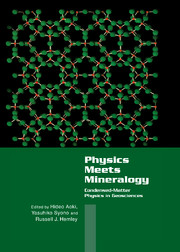Book contents
- Frontmatter
- Contents
- Preface
- List of Contributors
- Part I Introduction
- Part II Advances in Theoretical and Experimental Techniques
- Chapter 2.1 Density Functional Theory in Mineral Physics
- Chapter 2.2 Crystallographic Orbits and Their Application to Structure Types
- Chapter 2.3 Accuracy in X-Ray Diffraction
- Chapter 2.4 Statistical Analysis of Phase-Boundary Observations
- Part III New Findings in Oxides and Silicates
- Part IV Transformations in Silica
- Part V Novel Structures and Materials
- Part VI Melts and Crystal–Melt Interactions
- Subject Index
- Materials Formula Index
- Index of Contributors
Chapter 2.4 - Statistical Analysis of Phase-Boundary Observations
Published online by Cambridge University Press: 05 November 2011
- Frontmatter
- Contents
- Preface
- List of Contributors
- Part I Introduction
- Part II Advances in Theoretical and Experimental Techniques
- Chapter 2.1 Density Functional Theory in Mineral Physics
- Chapter 2.2 Crystallographic Orbits and Their Application to Structure Types
- Chapter 2.3 Accuracy in X-Ray Diffraction
- Chapter 2.4 Statistical Analysis of Phase-Boundary Observations
- Part III New Findings in Oxides and Silicates
- Part IV Transformations in Silica
- Part V Novel Structures and Materials
- Part VI Melts and Crystal–Melt Interactions
- Subject Index
- Materials Formula Index
- Index of Contributors
Summary
A statistical method that uses a generalized linear model is presented to provide best-fit phase boundaries to experimentally determined phase-diagram data. The experimental determination of the exact locus of a phase boundary is inherently uncertain because of increasing difficulty in determining the presence of one phase and/or the absence of another as the phase boundary is approached from either side. We present a logistic model, which states that a phase transformation α → β can be expressed in terms of the probability of observing β at a given set of measured state variables X and Y such that the phase boundary is defined as P(β | X, Y) = 0.5. As an example, high-pressure and high-temperature data for the melting curve of platinum are analyzed with this method.
Introduction
Phase diagrams are determined by recording the state of a material at a series of thermodynamic conditions, for example, whether the sample is molten or crystalline as a function of temperature, composition, and pressure. Although phase boundaries are thermodynamically well defined, the experimental observations that constrain phase diagrams often display significant scatter about the equilibrium boundaries. The scatter may be evident either within a single set of measurements or between distinct experiments from different laboratories.
- Type
- Chapter
- Information
- Physics Meets MineralogyCondensed Matter Physics in the Geosciences, pp. 71 - 80Publisher: Cambridge University PressPrint publication year: 2000



